Notre Dame dominated Virginia down-to-down, but officiating and startling momentum shifts on Senior Day gave this game a strange flow. Once again Al Golden’s defense was dominant, forcing 5 turnovers and Cavs QB Anthony Colandrea to the bench after he accumulated -17 expected points added (total EPA) for the game.
For a second straight week the Irish offense struggled to find early traction. Notre Dame’s first five drives ended in just seven points and 60 yards, with the touchdown a gift off a short field thanks to a flubbed opening kick (also was aided by an unnecessary roughing the passer penalty). After constantly facing 3rd and longs with several offensive penalties, Riley Leonard’s first successful pass of the game didn’t occur until there was 8:43 left in the 2nd quarter!

Still, this game was secure by halftime thanks to the Irish defense. Despite a mediocre 5.8 yards per play offensively in the first half, Notre Dame was comfortably up 28 as the marshmallow started flying. Garbage time begins up 29+ in the 3rd quarter, so in this game after Jeremiyah Love’s long run put ND up 35-0. Technically this game could have come in and out of garbage time with UVA’s following touchdown, but I’m comfortable throwing those plays out – especially since that drive was fueled by a terrible missed call.
Somehow the officials in the Notre Dame Virginia game ruled this a catch, Cavs scored a TD 4 plays later: pic.twitter.com/yDmcvgMK2T
— John Brice (@JohnDBrice1) November 16, 2024
The Broyles Award should be Al Golden’s to lose
I could recycle all of Notre Dame’s elite defensive rankings here, but all of the top-5 categories start to bleed together. Arguably more impressive is the context for this defensive dominance. There’s one 1st round NFL lock on defense and Benjamin Morrison has been out since mid-October. The passing defense has been the best in the nation with a true freshman and two sophomores who didn’t start last year holding things down alongside Xavier Watts excellence and two veteran transfers. The linebacker rotation is a rotation of very old (Jack Kiser) and young inexperienced faces, but they’ve been deployed and developed excellently. The defensive line lost its top two pass rushers and has had most veteran members of the rotation (Cross, Burnham, Rubio, Onye) miss time.
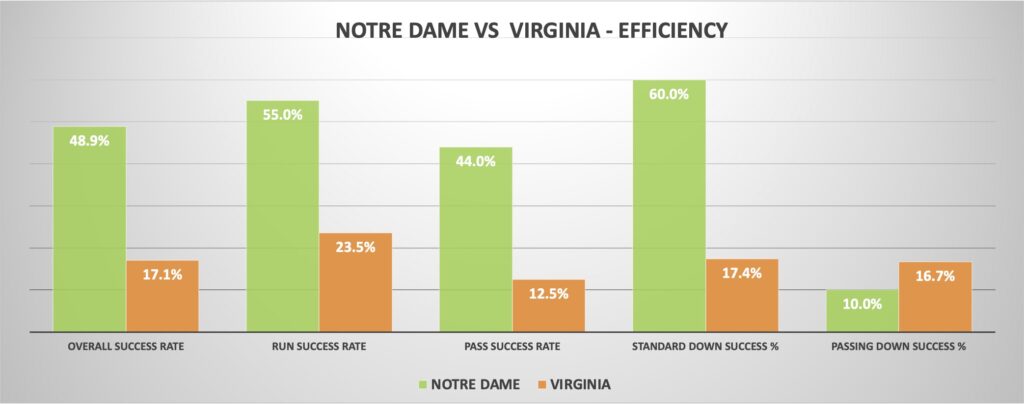
Virginia couldn’t get anything going offensively in any phase of the game. As usual, the run defense was relatively more giving (5.06 yards per carry) over the passing game (3.00 yards per dropback) for the Cavaliers offense. Before garbage time, UVA’s average drive was 3.7 plays (before special teams) and 14.4 yards gained.
Colandrea’s let it rip style seemed doom from the jump against Golden and the Irish defense on the road. His performance started with normal inefficiency, and then the interception dam quickly broke and the flood began. But Colandrea has good company – opposing QBs have been harassed by Golden throughout the year. Looking at total EPA per game (passes and runs included), he’s just the latest to pile up some astonishing negative numbers.
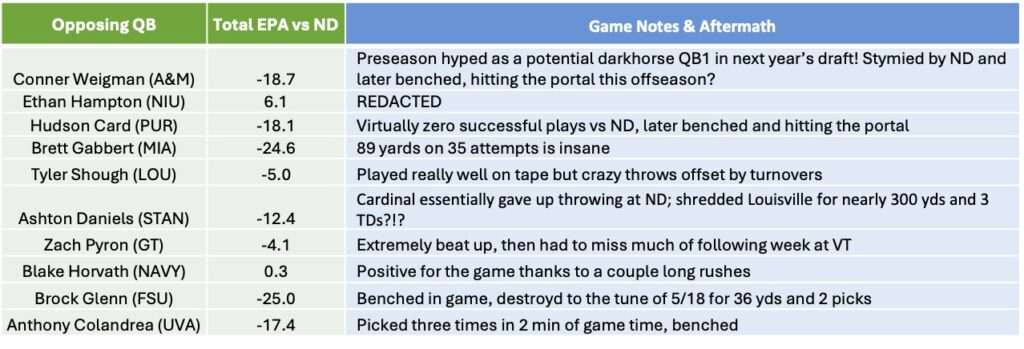
(Context here: Having negative EPA in a game isn’t uncommon, but you have to really struggle to get deep into negative numbers. Even the 91st ranked FBS QB has positive cumulative EPA for the season).
Look, these are not the finest QBs and passing games our nation has to offer. Just two passers above are within the top 88 nationally in ESPN’s QBR (Horvath at 5th, Shough at 25th). Weigman, Pyron, and Glenn don’t have the snaps to qualify and the others have struggled regardless of opponent (Card 97th, Gabbert 104th, Daniels 90th, Colandrea 106th). Still, if you compare opponent passing dropbacks against the Irish defense against their season-long averages, you can see the impact:
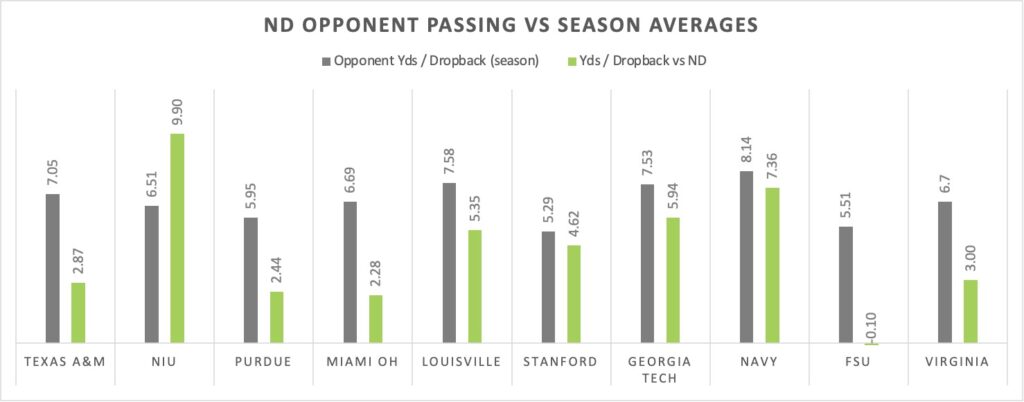
After a 5-turnover day for UVA, the Irish defense is now tied for 1st nationally with 25 turnovers gained, and 2nd overall in turnover margin (+1.5 per game). This is incredibly impactful but usually a watch-out area for regression whenever a team stands out in this area given the randomness of fumbles and interceptions.

But both for this game and the season, Notre Dame hasn’t been lucky covering more fumbles or picking off more passes than expected. Virginia was actually expected to turn the ball over close to the five they committed (although this does count the sketchy “completion” above as a catch and fumble).
Similarly, if you look at Notre Dame’s expected turnovers for the season (using the national average of 50% fumbles recovered, 22% of pass break-ups coming as interceptions) you end up with a virtually identical turnover margin (+1.52 per game, 23.9 opponent turnovers). This is a team that offensively doesn’t put the ball in danger much and defensively is constantly making things happen (t7 in forced fumbles per game, 12th in pass break ups per game). The only real source of lucky has been in games like Navy where there are a lot of opponent fumbles without the Irish technically forcing them.
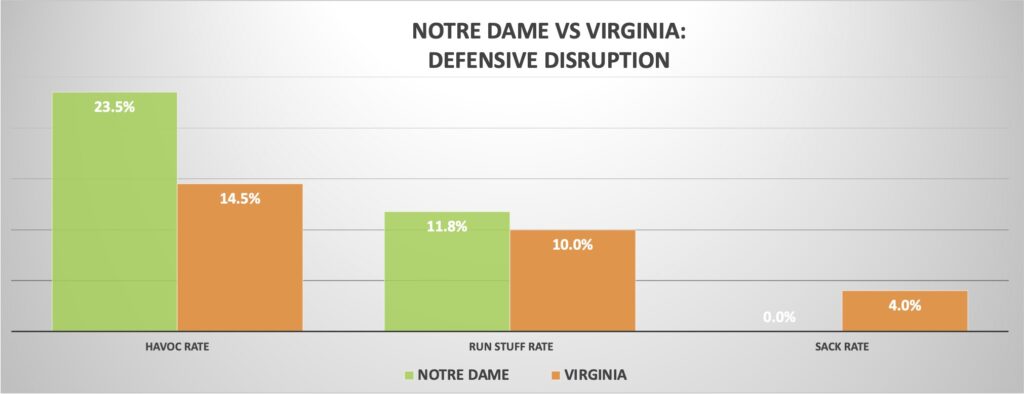 Once again, Al Golden has locked in a formula for forcing turnovers but not necessarily creating tons of negative plays. The Irish are just 81st in tackles for a loss per game, and similarly average or below in stuff rate (which just focuses on runs, and includes runs for no gain). As a result the havoc is pretty dependent on the secondary making plays on the ball (and the pass rush creating the pressure to cause these tight throws, even if they don’t always get home).
Once again, Al Golden has locked in a formula for forcing turnovers but not necessarily creating tons of negative plays. The Irish are just 81st in tackles for a loss per game, and similarly average or below in stuff rate (which just focuses on runs, and includes runs for no gain). As a result the havoc is pretty dependent on the secondary making plays on the ball (and the pass rush creating the pressure to cause these tight throws, even if they don’t always get home).
Despite the points, a clunky performance for the Irish offense
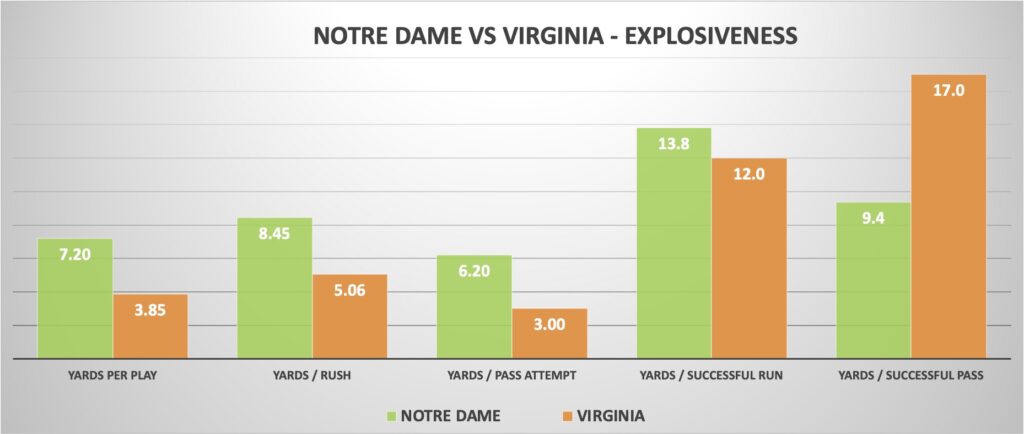
After a few weeks where it looked like the Irish offense was taking a step forward, especially in the passing game, things seem to have stalled out a bit. The points off turnovers and short fields conceal that this was an offensive performance in the bottom third of games so far this year. FEI’s nifty game rating puts this performance on par with another wheezing offensive gameplan, the Miami-OH game, and it was the 3rd worst performance in terms of available yards gained (a measure of how well you move the ball compared to the possible yards each possession to score) behind NIU and Louisville.
The rushing game wasn’t the issue, as offensive penalties completely derailed several 1st half drives and led to an average 3rd down distance of gain of 12.2 yards before garbage time. Unsurprisingly, the Irish converted zero of these 3rd and longs. A week after tallying a season-high 5 passes of 20+ yards, there were zero against the Hoos. Riley Leonard graded out fairly well despite an uncharacteristic interception that was a bad idea the moment it left his hand. But it still feels like the passing operation as a whole is always an inch away from entering multiple series slump, whether that’s from stale playcalling, Leonard’s placement being off, the offensive line yielding pressure, or receivers struggling with drops and separation.
Wide receiver continues to be a week-to-week adventure, as Beaux Collins had a rough week (1 catch on 3 targets – 16-yard gain on 3rd and 22). Collins and Jordan Faison both have red flags next to their names with their current drop rates (PFF has Faison now with 4 on 20 targets). Jayden Harrison’s emergence is a nice wrinkle – is he the fastest receiver as well as the one with the best hands? But Jaden Greathouse suffered an early mior injury to prevent him yet again from stringing a few productive games in a row together. It’s not insurmountable, but Notre Dame’s passing game is firmly in the discussion of the worst units among the playoff contending teams (excluding the potential ACC/Big 12 / G5 automatic berths).
Before garbage time Notre Dame was again excellent converting scoring chances, with only one failed field goal attempt. Unfortunately in garbage time the Irish tanked those red zone and points per scoring chance metrics with another field goal miss and a failed 4th and goal attempt.
The placekicking situation is dire. If there’s some saving grace, Marcus Freeman’s 4th down decision-making has been encouraging the vast majority of the year, and the lack of trust in the kicking game may only encourage him into more aggressive / correct decisions. Still, even in this pro-analytics space there’s a time and place for field goals, and it’s discouraging that the best option may be just to light candles at the Grotto for Mitch Jeter’s groin to be healed come December.
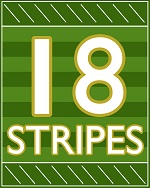
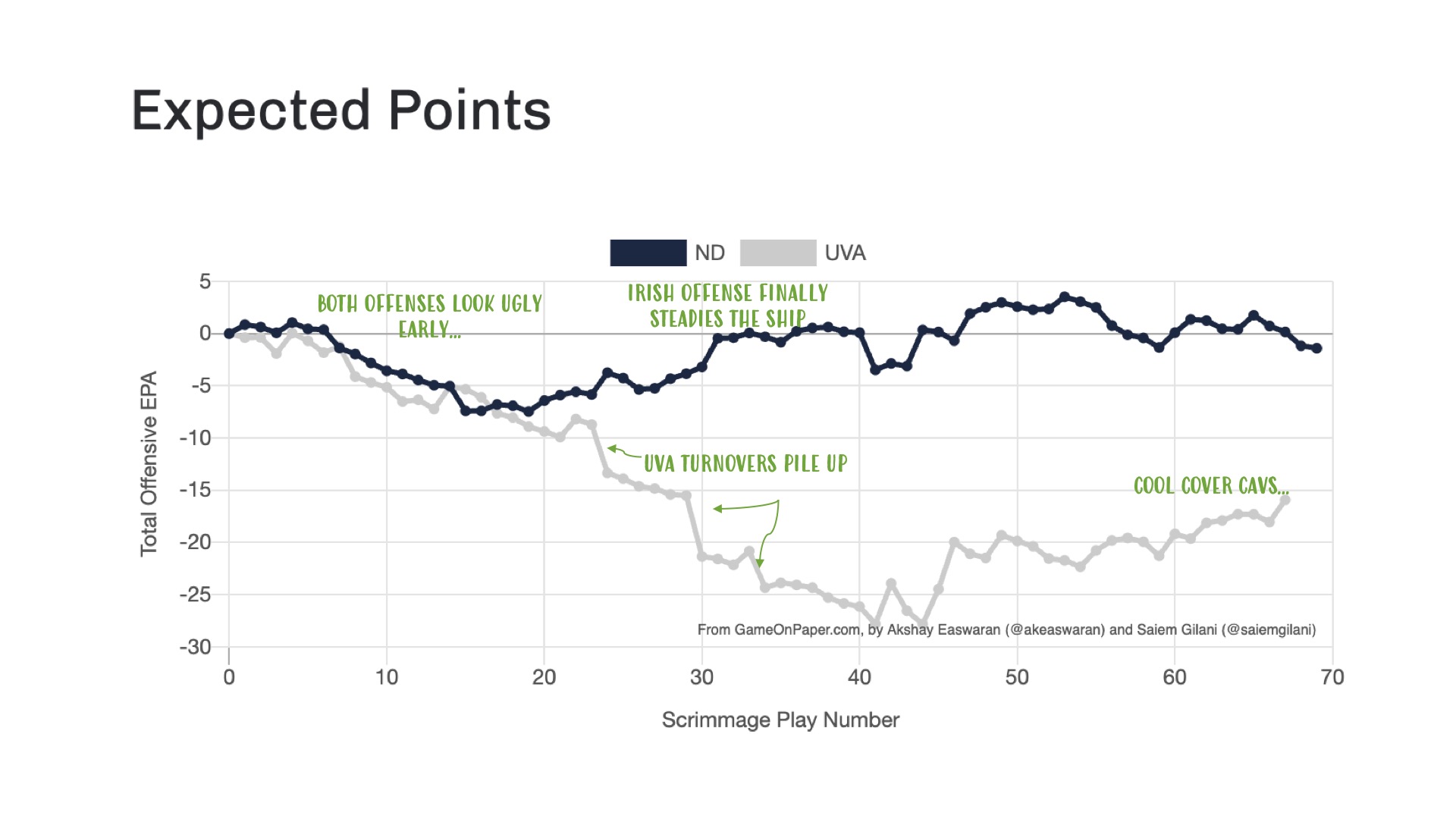
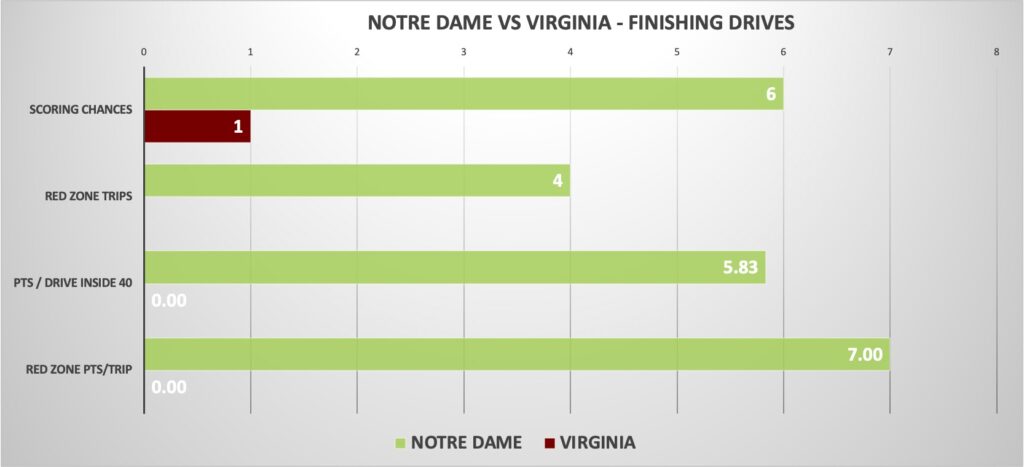

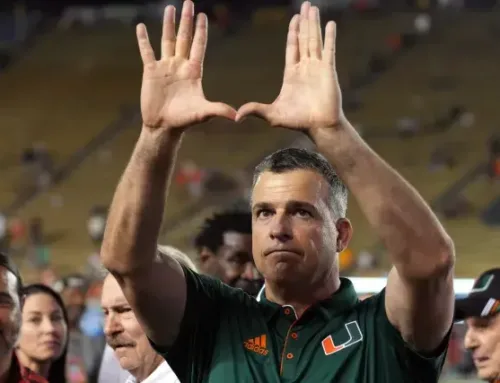
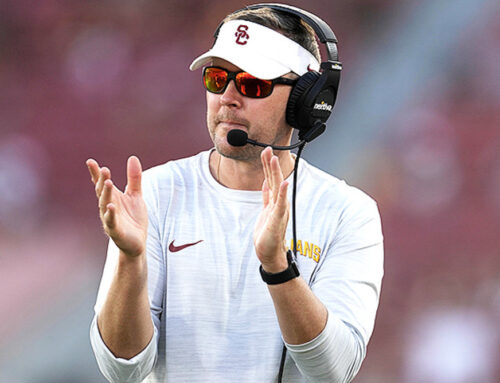
Riley Leonard is going to have to put the three games of his life together in the playoffs for us to have a chance. The defense has been lights out this year, but against CFP teams, we need an offense to. I attribute Faison’s drops to being a bit rusty. Collins, I have no explanation for. There is a reason he wasn’t receiver #1 at his previous school.
Speaking of CFP, don’t want to draw ‘bama in first game, even with Saban gone. Two or three more years, I’ll be good with it. Also Kiffin’s comment about teams not wanting to play in the SEC championship due to risk of being knocked out of CFP I thought was interesting. Power 4 HC contracts might get rewritten so that an appearance in the championship game and knocked out of the playoffs has more incentive than getting a 5-12 seed in the CFP.
That said, if the committee put a 3 loss SEC team in, I would be pissed. SEC builds a super-conference of marquee brands, they don’t have any right to expect a three loss team to be seeded. They made their bed.
While I heartily agree that we need the best Riley we can get, I don’t think we need him to be better than he’s ever been.
We also have 2 or 3 really good running backs, so I think a moderately good RL combined (great running as always with no major mistakes in passing) with really good days for the OL and the RBs might also be a winning formula.
Avoiding Georgia as long as possible would also be nice.
The scary thing there is that ND needs Leonard to be a great runner to have a great offense. But as the bracket is laid out now, I don’t see a running QB surviving 4 straight games against Alabama, Oregon, Ohio State, and Georgia. I love how tough he is, and his ability to take (and deliver) contact is possibly his greatest skill. But can that really hold up for 4 straight games against those athletes? I would be shocked.
So the alternative is he becomes a great pocket passer? Unlikely. But if Harrison is actually a legitimate deep threat, and Leonard can hit one of those per game, maybe that does enough to open things up where the running backs can get space without the constant threat of Leonard running. Maybe. I certainly wouldn’t envy Mike Denbrock if that’s the way the bracket plays out.
I think we should consider it a pretty big win that we are seriously talking about winning playoff games – a month and a half ago, even when I thought there was a chance of winning out I thought this team would have zero shot against a half-decent team. Then Ben Morrison got hurt! And still, it does seem like we would have a puncher’s chance against the top-5 teams now that Leonard looks above-average with the potential to string together a couple great games in a row.
As long as the SEC only gets 4 teams in I don’t really care if they take the three-loss SECCG loser, for instance, because every one-loss P4 team would still have their spot.
If they’re arguing for knocking out one-loss P4 teams that don’t play conference championships (PSU/IU/ND, presumably) for a spot for a three-loss team then I agree, everyone should be pissed.